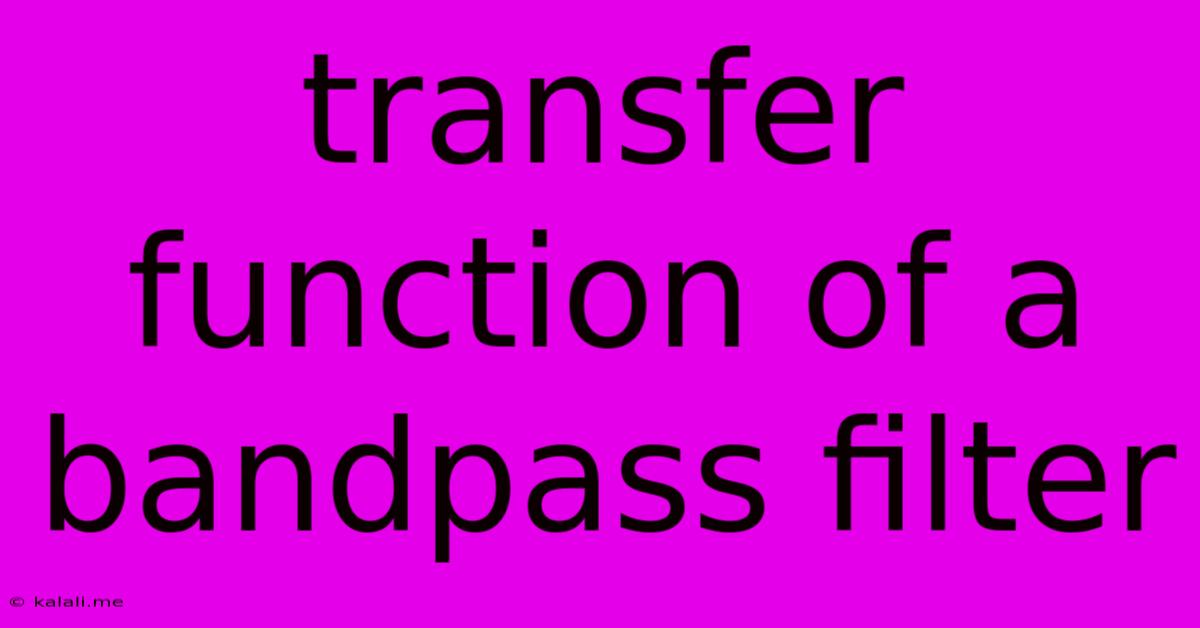Transfer Function Of A Bandpass Filter
Kalali
May 28, 2025 · 4 min read

Table of Contents
Understanding the Transfer Function of a Bandpass Filter
The bandpass filter, a crucial component in signal processing, allows signals within a specific frequency range to pass through while attenuating signals outside this range. Understanding its transfer function is key to designing and analyzing these filters. This article delves into the intricacies of the bandpass filter transfer function, exploring its characteristics, derivation, and applications. This will equip you with the knowledge to effectively utilize and implement these filters in various signal processing applications.
What is a Transfer Function?
Before diving into the specifics of a bandpass filter, let's establish a basic understanding of transfer functions. In the context of linear time-invariant (LTI) systems, the transfer function, often denoted as H(s) or H(jω), represents the ratio of the output signal to the input signal in the Laplace (s-domain) or Fourier (jω-domain) transform. It essentially describes how the system modifies the frequency content of an input signal. Analyzing the transfer function reveals critical information such as gain, phase shift, and frequency response.
Transfer Function of a Bandpass Filter: A General Overview
The transfer function of an ideal bandpass filter is a rectangular function in the frequency domain. It has a constant gain (usually 1) within the passband (the desired frequency range) and zero gain outside this range. However, ideal filters are not physically realizable. Real-world bandpass filters exhibit a gradual transition between the passband and stopbands (frequencies where the signal is attenuated). This transition region is characterized by a certain roll-off rate.
The general form of the transfer function for a second-order bandpass filter (the simplest form commonly encountered) can be represented as:
H(s) = (Ks) / (s² + 2ζω₀s + ω₀²)
Where:
- K is a gain constant that determines the filter's amplification within the passband.
- ζ (zeta) is the damping ratio, indicating the sharpness of the filter's resonance. A lower ζ value leads to a sharper resonance peak.
- ω₀ (omega naught) is the center frequency (or resonant frequency) of the filter, defining the middle of the passband. This is the frequency where the filter's gain is maximum.
Analyzing the Transfer Function
Several key aspects of the transfer function provide valuable insights into the filter's behavior:
-
Center Frequency (ω₀): This frequency determines the center of the passband. Signals around this frequency experience minimal attenuation.
-
Bandwidth: The bandwidth defines the width of the passband, typically measured at the half-power points (where the gain is reduced by 3 dB from its maximum value). The bandwidth is directly related to the damping ratio (ζ) and the center frequency (ω₀).
-
Q-factor (Quality Factor): The Q-factor is a measure of the filter's selectivity, indicating how sharply it discriminates between frequencies within and outside the passband. A higher Q-factor results in a narrower bandwidth and higher selectivity. It's inversely proportional to the damping ratio (ζ).
-
Roll-off Rate: This represents the rate at which the filter's gain decreases outside the passband. It's usually expressed in dB per octave or decade. Steeper roll-off rates are desirable for better signal rejection.
-
Phase Response: The phase response of the filter describes the phase shift introduced to different frequencies. Analyzing phase response is crucial for understanding the filter's impact on the signal's timing characteristics.
Different Implementations and Filter Types
Bandpass filters can be implemented using various circuit topologies, including RLC circuits, active filters using operational amplifiers (op-amps), and digital filters using software or dedicated hardware. Different filter types, such as Butterworth, Chebyshev, and Bessel filters, offer different trade-offs between sharpness of cutoff, ripple in the passband, and phase response. The choice of filter type depends heavily on the specific application requirements.
Applications of Bandpass Filters
Bandpass filters find extensive applications across various domains, including:
-
Audio Processing: Selecting specific frequency ranges in audio signals, such as isolating a particular instrument's frequency range in a mixed recording.
-
Radio Communication: Selecting a specific radio frequency channel while rejecting interfering signals.
-
Medical Imaging: Filtering specific frequencies in medical signals for enhanced image clarity.
-
Image Processing: Enhancing or suppressing particular frequency components in images for noise reduction or feature extraction.
-
Control Systems: Filtering out unwanted noise and disturbances from control signals.
By understanding the transfer function, designers can tailor the filter's parameters to precisely meet the demands of their specific application, making the bandpass filter an indispensable tool in signal processing.
Latest Posts
Latest Posts
-
Can You Bring A Laptop On Plane
May 30, 2025
-
Should I Ask Before Listing Someone As A Reference
May 30, 2025
-
Can A Dehumidifier Cool A Room
May 30, 2025
-
It Will All Come Out In The Wash
May 30, 2025
-
Is Phi Kappa Phi Worth It
May 30, 2025
Related Post
Thank you for visiting our website which covers about Transfer Function Of A Bandpass Filter . We hope the information provided has been useful to you. Feel free to contact us if you have any questions or need further assistance. See you next time and don't miss to bookmark.